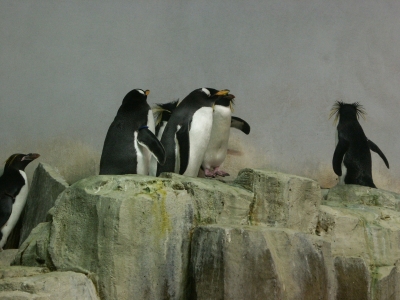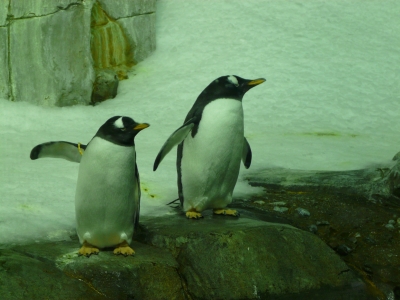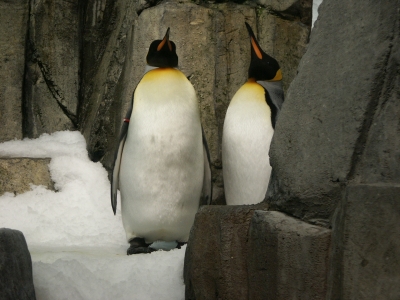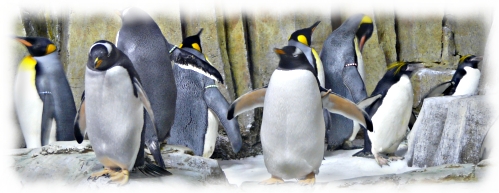Penguins - intro
Penguins are popular and adorable animals. Linux, the computer operating system has adopted a penguin as its mascot, a big publishing house chose a penguin as its name...My first memory of penguins is actually a cartoon. A greyish white penguin comes into a shop and wants a new jacket. He tries on all the jackets the shopkeeper has to offer but none of them really fits and makes him smile. Finally when hope of finding a good one is fading the shop keeper remembers that he has one last jacket, a used one. He brings it and ... the tailcoat is excellent for him. Happily he leaves the shop in his new jacket.

Most penguins live in the southern hemisphere
In 1995 I was lucky to be able to travel to Australia and see the fairy penguins (also known as little blue penguins) on Philip Island. They are a big tourist attraction. It's really unbelievably cute to see them slowly waddle ashore in the evening.There are many different species of penguins. The biggest is the emperor penguin who lives in Antartica and the smallest the one we watched, the little blue penguin who is found around the coasts of Australia and New Zealand. The emperor penguin gets up to 122cm high and weighs between 22 and 45 kg while the little blue penguin only grows to between 30 and 33 cm and weighs around 1.5kg.
Except for one species all penguins live in the southern hemisphere, around the coasts of Australia, New Zealand, South America, South Africa and Antartica. Only the Galapagos penguins live north of the equator. Generally speaking the bigger penguin species live closer to the Antarctic and the smaller they are the more likely they are to live in warmer, more temperate climates, probably as larger bodies are better in keeping their heat than smaller ones. Penguins can't stand hot climates though and the Galapagos penguins can only survive due to the cold Humboldt currents.
Still the climate in many places in the northern hemisphere would be suitable for them. A possible explanation to why penguins don't live in the northern hemisphere is that there are too many predators around the shore and most of all on land so that they couldn't go on land and breed savely. In the southern hemisphere they have very few enemies on land. There are seals waiting for them while they go ashore but once they have reached the land they are safe. Skua birds, sheathbills, giant petrels, various kinds of gulls and a few other birds try to attack their chicks and eggs but they are no danger for adult penguins and often adults can chase away those birds and protect their chicks successfully.
There was an experiment that put penguins to live around the coasts of Norway but this wasn't really successful. The penguins survived and lived as long as in the southern hemisphere but they never tried to mate and have offspring. However they were successfully breeding in zoos which suggests that it's really the enemies on land and not the climate that is the decisive factor.
Depending on the species of penguins they can live up to between 6 and 27 years.
Penguins fly through the water
Penguins are birds but they cannot fly through the air. Instead they fly through the water. It is supposed that penguins lost their ability to fly because you can't be a master swimmer and a master flyer at the same time. Wings must be relatively large to be able to gain enough lift for flying through the air but in the much denser water a smaller, more rigid structure is more advantageous. It's easier to beat them more often and at a higher speed. As penguins don't have any real enemies on land flying wasn't necessary while being the best swimmer possibly gave them an advantage. Being great swimmers enables them to escape many predators in the water and also to better catch prey for themselves. And so their wings transformed into flippers.Their body form is more wavelike. This shape together with their feathers lets the water flow along them without any whirls forming. That way they can fly through the water without much resistance.
Their short legs together with their big feet serve as rudders or paddles. Their legs are set far back which gives them their upright and straight posture. This helps to streamline the body and with steering while swimming. Streamlining means that there is less resistance to cross the water which means less energy is needed. Less energy means that they need less food to survive and strive.
Their heavy bones also help them to stay underwater.
Their feet are webbed and have visible claws. In the water the webbed feet are like a paddle or rudder but on land they are very useful too. On land the webbed feet make it easier to walk through the snow as they act as a kind of snowshoes. The bigger surface of the toes spreads their weight over a bigger snow surface and so they don't sink into the snow. The claws are very helpful too. It's like when we wear spikes on our shoes in winter to get some grip while waddling (or in our case walking) on the ice.
On land they waddle or slide along the ice. The sliding is called tobogganing. For them this is the most efficient way to move forward. Again the energy thing. Of course they are not really that energy efficient when walking the way their body is built. But scientists have found out that the waddling, the side to side rocking movement, lets them raise their center of mass. A raised center of mass means the body falls over more easily which is what you want if you want to walk forward quickly. Otherwise their muscles would need to work harder.
Even though their legs are very short penguins do have knees. However both their knees and their upper legs are covered with feathers and therefore not really visible. You can see their knees under an x-ray machine though. Sometimes instead of waddling penguins just slide on the ice. To accelerate themselves forward they generate the needed force by bending their knees and pushing them against the ice underneath.

Penguins are excellent jumpers
Penguins can do another thing really spectacularely well and that is: they can jump. Depending on the species they can jump up to 3m high, that means they can jump much higher than their own height. To get to the shore they would have a hard time and be incredible slow to climb over all the rocks and pebbles lying around. However the most danger for penguins lurks when they get in and out of the water so they need to be able to be quick. The solution for this is to jump. They propel themselves out of the water by swimming quickly to the surface releasing air bubbles from the layer of air between their feathers and then bursting through the water surface and flying through the air before landing safely on their breasts.The important thing are the air bubbles as they reduce the drag enough to get them up into the air.
Before the penguins go in the water they raise their plumage to fill the layer of air between their feathers with as much air as possible. Under water with rising water pressure the volume of the air shrinks and the penguins lock the air with their feathers with that smaller volume. When they want to get out of the water they speed up as much as they can and the air volume expands because of the decreasing water pressure and the air leaps out of the feathers surrounding them with a coat of air that is helping them to reduce the drag. It's the same method that engineers use to speed up boats. Their speed together with the reduced drag is enough to propel them out of the water and into the air.
First I wondered if the penguins don't hurt themselves when they land on the hard ice on their breasts. But I guess that their blubber and feathers are protecting them especially as while they jump up high they don't really fall down that much.
To go on land penguins jump out of the water and onto the land. When they go back into the water they also have to jump back in. In the water a healthy adult penguin has a good chance to outswim its predators but jumping on land and jumping back into the water are situations where they are in big danger of being eaten. The seals often wait for them there. The faster a penguin can exist the water the less it is in danger. As penguins are social animals they often swim and chase for food together and go on land together. To get back into the water they often go to the edge of the water single file. They wait until one of them falls or jumps into the water. If this penguin survives the others quickly follow because then they know that it is save to go.
Penguins are fast swimmers. Gentoo penguins are the fastest, they can speed up to as fast as 36km/h. To swim really quick penguins can decrease the water resistance by trapping air in their dense coat of feathers. Usually penguins swim between 6.5 and 11 km/h depending on the species. They can also change their direction extraordinarily fast which helps with escaping their predators. Leopard seals and other seals as well as killer whales (orcas) are their biggest enemies. However bad weather is also a big killer for penguins.
If penguins are attacked they defend themselves with their beak and wings. They bite the predator with their beak and beat it with their wings.
Penguins can't breathe underwater but need to come up for air. Usually they frequently leap up and forward for air while swimming. This is an energy efficient way to swim forward fast. Actually it only works at high enough swimming speeds. To propel themselves out of the water the penguins need more energy than swimming straight forward normally but flying forward through the air is very energy efficient. If the speed is high enough it saves more energy to constantly leap out and into the water.
Most penguin species can also hold their breath for as long as 15 min while the emperor penguin can even hold its breath for as long as 27 min. The larger the penguin the longer it can dive.
Penguins have a higher level of hemoglobin, the protein that carries oxygen through the blood which makes it possible for them to have more oxygen in their body. They also have a higher level of myoglobin which carries the blood in the muscles. And they are able to slow down their heart rate while diving which makes those oxygen supplies last much longer still. Their normal heart rate at rest is 60-70 beats per minute. Before diving they load themselves up with oxygen and their heart rate goes up to 180-200 beats per minute. While they dive the beats slow down to only 20 beats per minute (bpm).
On average penguins dive up to 9-18m deep to find their food. They have a special organ to help them with the different water pressures. They have ears but they don't have external ear flaps. Their ears are holes covered with feathers. Their middle ear has a special organ made of cavernous tissue. When the water pressure increases this tissue expands and therefore closes off the middle ear and ensures a constant pressure this way.
Penguin food
Penguins eat fish, squid and krill. They are carnivores.As penguins eat a lot of crustacean food which contains a lot of salt they have evolved special glands which are able to extract and expell the salt. The salt is expelled either through their bill or by sneezing. Penguins can therefore drink salt water. However if they are thirsty they drink melt water or eat snow.
Like all birds penguins don't have teeth and swallow their food whole. They catch and kill their prey with their beak. Their tongue has some kind of spikes on it that hold the prey tight making sure it can't escape. Like other toothless animals they also eat stones which are supposed to help with digestion.
Scientists are not sure yet if penguins can differentiate different tastes as they haven't been able to find any taste buds yet. They have found taste genes for salty and sour though. The question remains if penguins can taste different foods or if they can't as it isn't necessary for an animal that swallows their food whole. Something for scientists to still work on.
Penguins have very good eye-sight both on land and in the water. For us humans everything looks a bit misty when we try to see underwater because of the different refraction of light in air and water. Not so for penguins. Their eye surface is less curved or a lot flatter than ours and they can change the shape of their lens a lot more which makes it possible for them to see clearly both on land and in water.
For spatial vision which they need e.g. to correctly estimate the distance to a fish penguins turn their heads to focus at the object first with one eye and then with the other.
As they spent so much time under water and underwater everything looks bluish green (as the yellow and red light rays are filtered out) they can differentiate those colors much better than red ones and better than we can.
For humans penguins of the same species almost look alike. If the penguins are together at a nesting site researchers can tell male and females apart by their different behavior and because males have slightly bigger beaks and are in general slightly bigger than females. However they mostly can't differentiate individual penguins from each other. But it seems that penguins themselves are easily able to recognize different individuals, mostly by the different sounds they make. They are noisy birds and communicate through their cries.
Camouflage
Penguins have a black back and a white belly. That's for camouflage. From above their black color makes them difficult to spot and the same is true for their white color looking from below. Looking up they blend in with their surroundings. Not giving their presence away is very helpful both in avoiding encounters with enemies as well as with catching food of course.Keeping warm
Penguins are warm blooded. A penguin's normal body temperature is around 38°C. Penguins have feathers and a lot of blubber that is a thick layer of fat to keep them warm. Blubber consists of oils extracted from the rich planktonic food they eat. It is a bad conductor of heat and therefore helps to insulate the body.Their feathers also help them to regulate the heat. Air is also a bad conductor of heat and the feathers overlap in such a way that they trap a layer of air next to their skin. It can keep them warm but they can also put them in a direction so that the heat can get out to prevent them from overheating. Their black feathers also help to absorb heat from the sun.
The penguins use the oil they get from their food to make their plumage water-repellent. They spend some time every day caring for their feathers as otherwise they wouldn't stay water proof.
Penguins spend between 50 and 80% of their lives in the water. But for breeding and changing their plumage which they do once every year and during which time their plumage isn't water-repellent they need to come ashore. It takes 2-3 weeks to lose and regrow their feathers and they can't swim and chase for food in the water during that time so they try to eat more before. The molting as the changing of feathers is called is necessary to replace old worn out feathers with new ones to always stay warm.

Raising their young
Penguins often live in big groups called rookeries where the young are born and raised. Those groups can consist of 200 or up to thousands of penguins. There is safety in numbers.Penguins lay eggs. Most penguin species build nests. Usually the males arrive first to secure a nesting spot. There is a lot of infighting and they steal material for their nests from each other. Those penguins that don't build nests (e.g. emporor penguins) don't fight. They keep the egg warm balancing it on their feet and stand still to conserve energy and only rotate places from time to time to stay warm as the ones the farthest outside have it pretty cold.
Most penguins lay 2 eggs but those that don't build nests only lay 1 egg. It is supposed that they lay only 1 or 2 eggs because the parents can't feed and raise more chicks at a time. Hatching takes around 1-2 month. Most penguins share the task of incubating and keeping the eggs warm between the two partners.
When the penguins have hatched they don't have water proof feathers yet and therefore need to stay on land. As soon as they grow and both parents need to go to catch enough fish they stay together with the other small chicks. Again there is safety in numbers. A few adults usually stay around to chase predators away though. The parents usually only feed their own young so the little ones depend on their parents to come back.
The soft down the little penguin chicks have is better insulating then the feathers the grown up penguins have. A larger penguin has a lower surface to area ratio than a little chick. The lower the ratio the smaller the loss of heat. As the chicks have a higher ratio they need a different kind of plumage to keep warm.
I guess that it also takes so long for them to grow water proof feathers as this keeps them out of the water as long as they are still too vulnerable and easy prey in the water. Little penguins are dependent on their parents for between 7 weeks and 13 months. After that they still stay close to their nesting ground and to their parents to learn how to fish and stay save. They learn how to swim without the help of their parents though starting to learn it in shallow waters. Many young and inexperienced penguins are welcome food for their predators and many of them die every year.
A penguin's favourite color is orange
Some penguin species have orange feet and beaks or at least a few orange or yellow feathers. A possible explanation for this color is that possible mates find this to be very attractive. The majority of penguin pairs will stay together for life and breed at the same spot year after year. However if breeding wasn't successful the pair is much more likely to split up. If the partner doesn't arrive on time the other will look for another partner but mostly get back together with the late comer when s/he arrives.Penguins can sleep both in the water or on land. When they sleep in the water they float on the water and only sleep for a few minutes at a time. At land at night with no danger of predators coming they sleep for longer periods of time. There they sleep either lying down or standing up like birds do.
Penguins like to slide down cliffs on their bellies just for fun like we like sledding down a hill in winter time.
What amazing animals penguins truly are!
By the way the photos were all taken in the biodome in Montreal, Canada.

Copyright © Katja Socher
